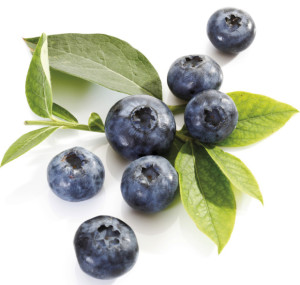Vacciniums: Am I Blue?
Blueberrying was a family tradition. The only debate was did you pick them clean, or did you pick leaves, bugs and all then clean the haul later? My mother preferred the clean method, so clean it was. Why did she prefer the clean-picking method? Because as a child she and her mother visited a friend who had just finished picking a lot of blueberries. My mother was asked if she wanted some, she said yes a big bowl. The bowl of blueberries were delivered then milk poured on them. That caused all the twigs, leaves and bugs to float to the surface making the berries not possible to eat. We picked clean.
 My most enduring memory, however, was when I was 14 and had just started high school. I was picking away late one season on a Sunday afternoon when a bee came up and stung me right on the end of my nose. Yes, it did swell up. Yes, I did look ridiculous. Yes, I was forced to go to school the next day, putting Cyrano de Bergerac to shame.
My most enduring memory, however, was when I was 14 and had just started high school. I was picking away late one season on a Sunday afternoon when a bee came up and stung me right on the end of my nose. Yes, it did swell up. Yes, I did look ridiculous. Yes, I was forced to go to school the next day, putting Cyrano de Bergerac to shame.
We berried in two very different areas with two very different kind of blueberries. Low-bush blueberries were extremely common, covering huge fields, hundreds of acres. The fields were burned every year to ensure a good crop of blueberries, which prefers poor acid soil and ashes. In late summer rows were marked by string. Pickers with hand rakes would come in and strip a field in a couple of days. They always focused on the productive center of the field, leaving the edges. We used to raid those edges on the weekend, collecting quarts of ignored fruit. But, there were other blueberries as well.
High on a ridge, west of the Libby Road where it intersects with the Witcher Road, in Pownal Maine, there’s a north south granite ledge showing here and there. On that ledge were the best specimens of high-bush blueberries I’ve ever seen. Tall shrubs, they were six to eight feet tall and loaded with large, sweet blueberries. Picking was fast, if there weren’t bears around, which brings me to a short story about my Great Aunt Myrt, born in the 1880’s. She loved blueberries.
Like all eight of her siblings born in the late 1800s, Myrt caught scarlet fever when she was in her teens and as a consequence was nearly stone deaf. That presented some problem, of course, but life went on. One day she was out with other members of the family picking blueberries. While they were picking a bear came along and started eating the berries right next to Myrt. Everyone but Myrt apparently saw the bear and moved away. Myrt kept right on picking. As you may imagine, the mostly deaf members of the family trying to get Myrt’s attention by yelling did not work nor did it scare the bear. Myrt was focused on filling her berry bucket. When her bucket was finally full she left the patch and joined the others.
“Didn’t you see that bear?” my grandfather shouted? “Yes,” said Myrt, shouting back, “but I wasn’t going to let that damned bear have my blueberries.” Myrt, a feisty, tall, good-looking woman, lived into her 90s. No doubt the healthful blueberries helped.
When picking off high bush blueberries it was not unusual to come home with a washtub full of them. You could eat fistfuls of blueberries and still have gallons left. In fact, the only way we ever ate them were either fresh or in muffins. Gallons of blueberries in the frig was a good feeling. The quantities of blueberries hereabouts are more modest, and sporadic.
The most common blueberry locally where I live now is Vaccinium myrsinites. There are no fields of them or even large patches that I’ve ever seen, always just a few short bushes here and there, usually around 18 inches high though they can get to three feet. Another local is the Vaccinium stamineum, Deerberry. It’s taste varies from tart to sweet. Deerberry is the easiest of all the blueberries to identify with leaves are egg-shaped and whitish underneath. The fruit can be green to deep ruby when ripe.
The high bush blueberry of my youth, Vaccinium corymbosum doesn’t quite get to Florida, or if so one foot across the state line. There is, however, a high-bush blueberry in Florida that grows to 20 feet or more, the Sparkleberry, aka Farkleberry, Vaccinium arboreum. It is edible but not too palatable. The bottom of its leaves have a net of gold-colored veins.
As you may infer, numerous birds and mammals like the blueberries. Among the creatures that like them are grouse, partridge, quail, robins, blackbirds, thrushes, chipmunks, deer, elk, rabbit and bear. Deer are quite fond of the leaves, a point not lost on hunters. Medicinally, decoctions of the leaves have been used for sore throats and diarrhea but if too strong can be toxic.
Vaccinium myrsinites is said vak-SIN-ee-um mur-sin-EYE-teez. Myrsinites is from Greek and means looking like the myrtle. What vaccinium means is more of a debate. One idea is that it goes back to a prehistoric European language called Thraco Pelagian, a precursor to Greek. A competing idea is that it is from the Latin word “vacca” meaning cow (frankly, both could be right since half of Latin is bastardized Greek, and the other half is misappropriated Etruscan.) The cow berry, Vaccinium vitis-idaea was common where plant namer Linnaeus was born, so…. we’ll never know. No doubt blueberries have been eaten for thousands of years and can be found in all lands circling the north pole then south. The oldest find is from a Bronze-Age grave in Denmark, a few thousand years ago. Two-hundred year old frozen blueberries have also been found in Northern Canada. In the Heath family, all Vacciniums — all 450 or so species — have a five-pointed, star-shaped calyx that remains on the fruit. Some Native Americans believed that in times of starvation “the Great Spirit sent the star berries down from the night of heaven to feed the children.”
If you have black blueberries with large leaves you may have huckleberries…. read that article here.
Green Deane’s “Itemized” Plant Profile
IDENTIFICATION: V. myrsinites is a small shrub, one to three feet, leaves alternate, ovate to elliptic, to 3/4 of an inch long, sometimes with fine, sharp teeth and spine-tipped. Leathery. Young grayish foliage often purple tinged. Flowers red or red-purple, in small compact clusters, bell-shaped, berries blue or blackish, round. V. darrowii looks similar but the base of the blossom is redder as are the tips of the blossoms.
TIME OF YEAR: Blooms in late May, fruit in the summer, June to August depending on area
ENVIRONMENT: A small bush with small fingernail sized leaves in saw palmetto prairies and pine flat woods
METHOD OF PREPARATION: Uses nearly too numerous to mention, jelly to wine, pies to confit, full of antioxidants.





